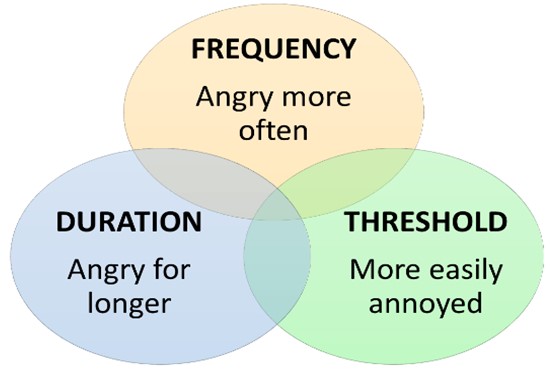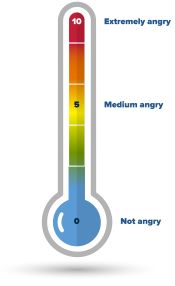
• Research Highlight
A persistent state of anger or annoyance along with frequent and intense outbursts of temper in children and adolescents often indicate clinically harmful irritability. Clinical irritability disrupts the child’s daily life and can continue to cause problems into adulthood. Although irritability is one of the main reasons children seek psychiatric care, it is understudied compared to other childhood disorders. Most importantly, evidence-based treatments for clinical irritability are also lacking.
In a new study, researchers at the National Institute of Mental Health (NIMH) successfully used exposure-based cognitive behavioral therapy (CBT) to treat severe irritability in children. This promising advance underscores the importance of personalized interventions in this area of child psychiatry.
What is severe irritability in children?

This study focused on severe and disruptive irritability and temper outbursts in youth. All children feel angry or irritable at times. Severe irritability is more serious and can cause problems at home, at school, and with friends.
Irritability and outbursts are part of many mental disorders, but they are core symptoms of Disruptive mood dysregulation disorder (DMDD). DMDD is diagnosed in children and adolescents who show constant irritability, frequent anger, and intense temper outbursts.
The symptoms of DMDD are serious and require treatment. Children with this high level of irritability get angry often and to a degree disproportionate to the situation and their age. When angry, they display outbursts of temper, usually involving high motor activity and verbal or physical aggression. These children are also persistently irritable or in a bad mood most of the time and in many situations.
How did researchers treat severe irritability in children?
Researchers led by Melissa Brotman, Ph.D., in the NIMH Intramural Research Program tested a new treatment for irritability. Developed in Dr. Brotman’s laboratory, the exposure-based CBT treatment It is based on a very effective treatment for anxiety: exposure therapy. In this pilot study, researchers examined the effectiveness, acceptability, and feasibility of exposure therapy for severe irritability.
Forty children (aged 8 to 17 years) participated in the study, which took place in the NIH Clinical Center . Children had to have at least one of the two main symptoms of DMDD: chronically irritable mood or severe temper outbursts. Some children also had co-occurring anxiety or attention-deficit/hyperactivity disorder (ADHD), but were ineligible to participate if they were diagnosed with other disorders, such as bipolar disorder, substance use disorder, schizophrenia, or autism spectrum disorder.
All children received 12 sessions of exposure-based CBT following an established manual written by Dr. Brotman. Each treatment session had a portion for children and parents.

- The children’s part focused on increasing frustration tolerance. Doctors carefully exposed children to anger-inducing situations, gradually ascending a hierarchy specific to that child. Examples could be taking away a favorite object (for example, stopping playing a video game or putting down the iPad) or initiating an unpleasant activity (for example, brushing your teeth or doing homework). The doctors worked with the child to learn to tolerate and respond constructively to her feelings without an outburst of temper.
- The parent portion focused on parent management skills. Parents were taught to actively ignore their children’s temper outbursts to stop reinforcing those behaviors. Instead, they learned to focus on and consistently reward positive behaviors.
Children were randomly assigned to be observed for 2, 4, or 6 weeks before starting treatment. Clinical observers did not know when active treatment began. This observation period allowed the researchers to confirm that the symptoms changed only after treatment began and were not factored into the doctor’s expectations about the treatment.
Clinicians, children, and their parents rated the child’s irritability symptoms and general functioning during the observation period, during treatment, and 3 and 6 months after treatment. Symptoms of depression, anxiety, and ADHD were also assessed for comparison. Acceptability, feasibility, and safety of therapy were determined by study dropout and adverse event rates.
Did exposure-based CBT treatment help children with severe irritability?
Irritability symptoms decreased significantly during treatment based on physician, child, and parent reports. Overall functioning also improved: at the end of treatment, 65% of children improved or recovered significantly as measured by clinical measures. Symptoms did not reappear after stopping treatment and, in fact, treatment gains were maintained at 3- and 6-month follow-ups.
When examining the core symptoms of DMDD, 60% of children were considered to have recovered on the Temper Outburst Scale and 25% on the Irritable Mood Scale at the end of treatment. This result suggests a stronger effect of exposure therapy in decreasing temper outbursts compared to improving irritable mood. In contrast, the treatment was not associated with significant changes in anxiety, depression, or ADHD symptoms, suggesting its specificity for addressing irritability.
No families dropped out of the study once treatment was initiated, suggesting that exposure therapy was acceptable and feasible. Similarly, no adverse events were reported, supporting the safety of using exposure therapy in children.
What can researchers do besides continue treating children with severe irritability?
Taken together, these results support the efficacy, acceptability, and feasibility of exposure therapy for youth with severe irritability. Symptoms of irritability and overall functioning improved during treatment, according to physician, child, and parent reports, and were maintained for several months after stopping treatment.
This study has some limitations. First, it had a relatively small sample size with limited racial, ethnic, and socioeconomic composition, which limits the generalizability of the results. Second, the study did not include a control group of children with irritability who did not receive treatment. Although the researchers addressed this concern through multiple observation periods, comparing this new treatment to current clinical care is a critical next step. Third, the study included a wide age range, so it is important to test whether there are differences in results by age. Finally, because clinicians administered the child and parent components at the same time, future studies could examine the individual contribution of child exposure therapy versus parent management skills to determine whether one is driving the effects. of the treatment.
The positive results of this pilot study laid the foundation to further explore CBT treatment for childhood irritability. Although the therapy is not yet ready for clinical practice, it offers one of the few evidence-based treatments for this common and harmful childhood disorder. Researchers plan to test and refine exposure therapy in larger, controlled clinical trials to advance the treatment of children with severe irritability and their families.
Reference
Naim, R., Dombek, K., German, RE, Haller, SP, Kircanski, K., & Brotman, MA (2023). An exposure-based cognitive-behavioral therapy for youth with severe irritability: Feasibility and preliminary efficacy. Journal of Child and Adolescent Clinical Psychology. https://doi.org/10.1080/15374416.2023.2264385







